| | Reducing runoff risks | Record keeping | Manure storage | Enforcement process
The purpose of AOPA is to ensure that the province’s livestock industry can grow to meet the opportunities presented by local and world markets in an environmentally sustainable manner. The Agricultural Operation Practices Act (AOPA) and regulations include manure management requirements for all livestock operations in Alberta. Producers using seasonal feeding and bedding sites (wintering sites), where livestock are fed and sheltered over the winter, must follow these regulations. Livestock corrals must also be managed according to the same requirements.
Under AOPA, all livestock producers are expected to follow the setbacks required from common bodies of water when locating wintering sites and livestock corrals. This practice will help minimize the risk of contaminated runoff potentially affecting the water quality of common water bodies. For more information on AOPA, please refer to the contacts at the end of this publication.
Terms the reader needs to know:
A common body of water* refers to the bed and shores of rivers, streams, creeks (both permanent and intermittent) and canals as well as reservoirs, lakes, marshes and sloughs that are shared by or common to more than one landowner.
The term manure* includes the livestock excreta, straw, other bedding material, litter, soil, wash water and feed in the manure. Composted manure has the same requirements as manure.* Terms used in this publication have been simplified to make it easier to read. Complete definitions are found in Section 1 of the legislation. This publication covers information on:
- reducing runoff risks
- manure storage
- record keeping
- enforcement process
Reducing Runoff Risks
Producers are expected to minimize the risk of runoff adversely affecting common bodies of water. Wintering sites and corrals must be located 30 metres (m) or more from a common body of water to reduce runoff risks (Figure 1).
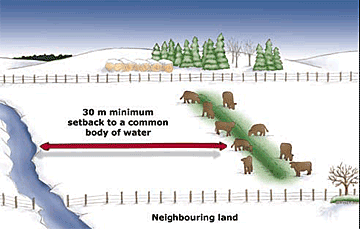
Figure 1. Wintering site or livestock corral setback distance requirements.
If the wintering sites or livestock corrals are closer than 30 m, one of the following options must be used to reduce runoff risks (Figure 2):
Option 1
An interceptor (e.g. berm or ditch) must be constructed between the site and the water to divert runoff away from the water.
Or
Option 2
Manure and bedding accumulated at the site must be moved to an appropriate manure storage facility or area before runoff occurs.
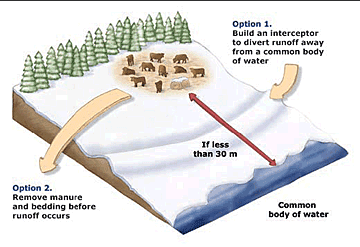
Figure 2. Options for sites that do not meet 30 m setback distance requirements.
Manure Storage
The requirements may vary depending on the type of manure storage used. Short-term solid manure storage sites are generally used to store manure collected from locations where manure has accumulated before it can be spread on the land. A short-term solid manure storage site can only be used for an accumulated total of seven months within a three-year period regardless of the amount of manure stored. In other words, manure can be stored in the field for up to seven consecutive months at one location in year one, and the site cannot be used for the next two years and five months.
If 500 tonnes or more of manure are stored for more than seven months in a calendar year on the same spot, the site used must meet the requirements in the legislation for a manure storage facility and a permit must be obtained from the Natural Resources Conservation Board (NRCB) for the manure storage. Feedlot pens must also meet the requirements for manure storage facilities, not short-term storage sites.
Note: The average cow/finisher produces about 2.16 tonnes of manure per year (depending on the amount and type of bedding used).
Producers with short-term solid manure storage sites must deal with runoff issues and must locate manure at least:
- 150 m from residences or occupied buildings that the producer does not own
- 100 m from a spring or water well
- 1 m above the water table
- 1 m above the 1-in-25 year maximum flood level
If the land slopes towards a common body of water, the setback distances in the following table must be observed:
Setback distances required for manure storage
| Average slope within 90 meters of a common body of water | Setback distance required from the common body of water |
| 4% or less | 30 m |
| Greater than 4% to less than 6% | 60 m |
| 6% or greater, but less than 12 % | 90 m |
| If the slope is 12% or more, do not store manure on the land. Once the slope is less than 12%, manure can be stored on the land. |
Short-term solid manure storage setbacks on land with less than 12% slope
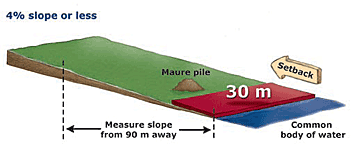
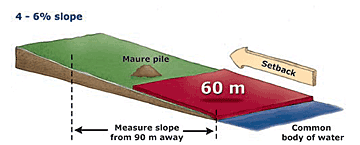
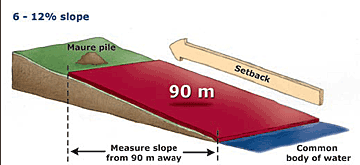
Short-term solid manure storage setbacks on land with 12% slope or greater
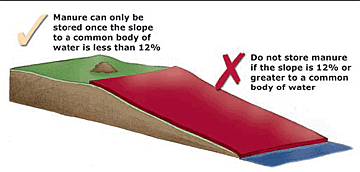
Even if setbacks are met, reasonable care must be taken to ensure manure does not enter a common body of water from runoff.
Record Keeping
Each person who handles 500 tonnes or more per year of manure must keep manure management records for five years and must conduct soil tests on the land where the manure is to be applied. The manure must also be applied according to the soil nitrogen and salinity limits in the legislation or an NRCB approved nutrient management plan. The soil test results for land on which manure is applied must not be older than three years, except for soil texture, which is a one-time analysis. The record keeping requirements do not apply to manure produced by livestock when they are grazing.
Records required:
- soil test results
- amount of manure produced or handled
- name and address of each person who receives or applies manure, as well as applicable dates
- land location where manure is applied
- application rates of manure and fertilizer
Further details and examples of record keeping forms are available from the contacts listed at the end of this publication.
Even if setbacks are met, reasonable care must be taken to ensure manure does not enter a common body of water from runoff.
Enforcement Process
The NRCB is responsible for administering the regulations under AOPA. Permits are required to build or expand a confined feeding operation (CFO), but not typically for a wintering site or livestock corral. Anyone planning to build or expand a wintering site or livestock corral should contact the NRCB before construction to check if the proposed structure(s) would require a permit. NRCB inspectors use a risk-based approach for monitoring and inspecting operations to ensure regulations and permit conditions are met. An inspection can be triggered if the NRCB receives a complaint. If a problem is identified, inspectors will work with operators to resolve the situation. When determining the appropriate enforcement response, inspectors will consider the significance of any non-compliance as well as the risk to the environment and the operator’s willingness to address the issue voluntarily.
For more information, contact:
(Dial 310-0000 to be connected toll-free)
Alberta Agriculture and Forestry
Lethbridge: 403-381-5885
Red Deer: 403-755-1475
Morinville: 780-939-1218
Ag-Info Centre: 310 FARM (3276)
Publications: 780-427-0391
Natural Resources Conservation Board
Lethbridge: 403-381-5166
Red Deer: 403-340-5241
Morinville: 780-939-1212
Fairview: 780-835-7111
Response line: 1-866-383-6722
* Terms used in this publication have been simplified to make it easier to read. Complete definitions are found in Section 1 of the legislation.
DISCLAIMER: This document is not intended as legal advice, but as an interpretive document to the Agricultural Operation Practices Act and Regulations.
Source: Agdex 096-4. Revised Sept 2015. |
|